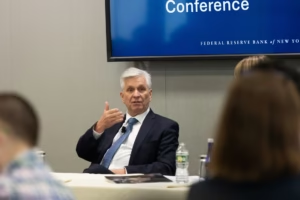The cooling methods produced by Vertiv are essential for AI data centers.
Vertiv Holdings Co., a developer of data center technology, has benefited greatly from the spread of artificial intelligence. However, according to Deutsche Bank, investors who were not there during the stock’s three-year surge of more than 1,600% can still profit in the future, albeit not to the same extent.
When you just look at how Vertiv’s stock (VRT) trades in relation to anticipated earnings, you can see that it is pricey compared to recent historical levels. Nicole DeBlase of Deutsche Bank pointed out that it trades at a ratio of 39x as opposed to its one-year median of 32x.
However, she believes it is more appropriate to consider the stock’s price to profits to growth ratio, which shows that it is relatively inexpensive from that standpoint as it tests in the bottom quartile of peer stocks in the electrical equipment and multi-industry sectors.
“A clear bifurcation in medium-term earnings growth algorithms between the secular growth ‘haves’ and ‘have nots'” is what she cited, and she believes this division will “persist for the foreseeable future.” She believes it is reasonable to examine Vertiv’s profile in comparison to its counterparts, some of whom are exposed to a macroeconomy that is more difficult.
According to DeBlase, Vertiv, which provides mechanical and electrical equipment for data centers, could profit from an estimated $7 trillion in total data-center infrastructure investments between 2025 and 2030. This figure is based on McKinsey predictions.
Since the company’s revenue base is now quite small, the market for its direct-to-chip liquid-cooling technology could expand much faster than that of general electric equipment. “Traditional data centers did not broadly require liquid-cooling infrastructure,” according to DeBlase. However, AI uses a lot of electricity and needs cooling systems to work as efficiently as possible.
DeBlase increased her price estimate for the company from $168 to $216, which indicates a 20% increase. However, she could see the stock reaching $230, or 27% above current levels, if she applied more bullish assumptions.
However, DeBlase is now thinking, “Is the bull case bullish enough?” due to the increasing commotion surrounding data-center investments. Among the recently announced agreements, she mentioned significant recent ones including those between OpenAI and Advanced Micro Devices Inc. (AMD) and Broadcom Inc. (AVGO).
“While it is impossible to know to what extent projects of this magnitude were already embedded in third-party data-center capacity forecasts, it does seem fair to say that if sizable project announcements continue, the bull case becomes increasingly likely – and the bull case may not even be bullish enough.”





